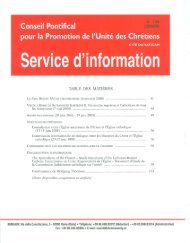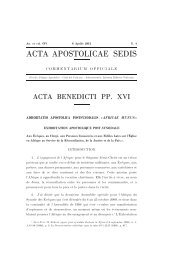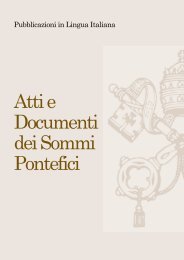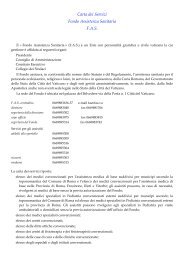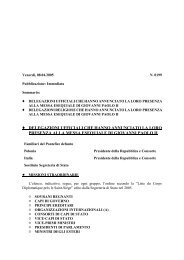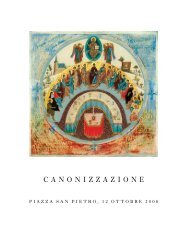ACTA APOSTOLICAE SEDIS - La Santa Sede
ACTA APOSTOLICAE SEDIS - La Santa Sede
ACTA APOSTOLICAE SEDIS - La Santa Sede
Erfolgreiche ePaper selbst erstellen
Machen Sie aus Ihren PDF Publikationen ein blätterbares Flipbook mit unserer einzigartigen Google optimierten e-Paper Software.
690<br />
Acta Apostolicae Sedis – Commentarium Officiale<br />
As canon 455 makes clear, the recognitio of the Holy See is required for<br />
any validly adopted decision of an Episcopal Conference which is to have<br />
binding force on all its members but it is not required for guidelines as such,<br />
nor is it required for the particular norms of individual Dioceses. Within the<br />
framework of ordinary episcopal jurisdiction, a Bishop is always free to enact<br />
laws or adopt guidelines for his own Diocese without any need to refer to the<br />
Holy See.<br />
While the Irish Bishops did engage in consultations with the Congregation<br />
for the Clergy about the contents of the Framework Document, the Irish<br />
Bishops’ Conference did not take the canonical vote required by canon 455<br />
§ 2 and never sought the recognitio of the Holy See for it. While the Congregation<br />
for the Clergy may contribute to the discussion leading to the<br />
formulation of complementary legislation, it is the Congregation for Bishops<br />
which is the competent dicastery for granting the recognitio to general decrees<br />
of the Episcopal Conferences in its territory. Since the Irish Bishops did not<br />
choose to seek recognitio for the Framework Document, the Holy See cannot be<br />
criticized for failing to grant what was never requested in the first place.<br />
However, the lack of recognitio would not of itself prevent the application<br />
of the Framework Document in individual Dioceses. Despite the fact that the<br />
Framework Document was not an official publication of the Conference as<br />
such, each individual Bishop was free to adopt it as particular law in his<br />
Diocese and apply its guidelines, provided these were not contrary to canon<br />
law. In the above-mentioned letter, Bishop Smith states: “All dioceses have<br />
accepted this document and set in place a framework for handling future allegations<br />
of child sexual abuse by priests.” The firm and determined approach<br />
adopted by the Irish Bishops was respected by the Holy See and made it<br />
unnecessary for it to intervene further.<br />
In the light of the findings of the Cloyne Report, the basic difficulty with<br />
regard to child protection in that Diocese seems to have arisen not from the<br />
lack of recognitio for the guidelines of the Framework Document but from the<br />
fact that, while the Diocese claimed to follow the guidelines, in reality it<br />
did not.<br />
As the Cloyne Report notes, the child protection guidelines of the Church<br />
in Ireland were revised and further improved in subsequent years, leading to<br />
the publication of Our Children, Our Church in 2005 and Safeguarding<br />
Children — Standards and Guidance Document for the Catholic Church in<br />
Ireland in 2009 (4.42-4.62). Unfortunately, the introduction of new




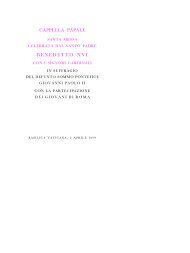
![AAS 01 [1909] - La Santa Sede](https://img.yumpu.com/51456523/1/180x260/aas-01-1909-la-santa-sede.jpg?quality=85)
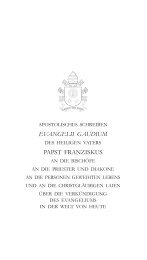
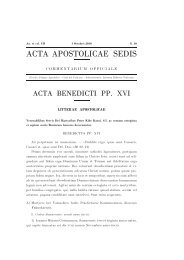
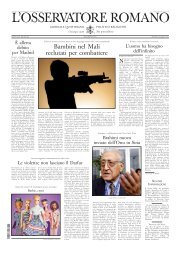
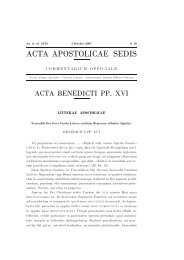
![AAS 20 [1928] - La Santa Sede](https://img.yumpu.com/19772818/1/180x260/aas-20-1928-la-santa-sede.jpg?quality=85)
